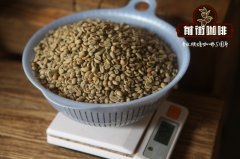Is coffee still divided into tree species? what are coffee tree species? what are the specific categories of coffee?

Professional coffee knowledge exchange more coffee bean information please follow the coffee workshop (Wechat official account cafe_style)
Species and characteristics of Coffee trees
In plant taxonomy, coffee belongs to the Genus Coffea family of Rubiaceae, and there are at least a hundred varieties of coffee under it.
Coffee trees are only suitable for planting in the tropics or subtropics. Today, there are three native species of coffee: Arabica, Robusta and Liberica.
Arabica (Arabica)
Originated in Ethiopia, accounting for about 70% of the world's total output, it is a tropical and subtropical high-altitude crop, so it is not resistant to high-temperature, dry, excessive humidity or low-temperature frost, long growing period, strong beans and small grains.
Robusta (Robusta)
Robusta is a variety found in Congo, Africa, which grows at low altitude, is resistant to disease, is resistant to high temperature and grows in rainy and humid conditions. Moreover, it has obvious "three high" characteristics: high bitterness, high caffeine and high aroma, but its aroma is slightly mildew, but the deeply roasted Robusta will show a special scorched fragrance.
Most manufacturers use Robusta, so high bitterness in iced coffee will add sugar and cream, but high caffeine cannot be removed and may be related to high levels of chlorogenic acid. as a result, many people will have heart palpitations, discomfort, and poor sleep.
Liberian card (Liberica)
Liberica is a Liberian tree species in western Africa, which can withstand all kinds of high and low temperature, wet or dry environment, strong fecundity, but poor flavor. Another disadvantage is that it will get leaf rust, so it is difficult to survive in the market and is generally used in research. more unable to plant a large number of production roughly classified as follows.
Ancient native species:
Typica: the oldest native variety in Ethiopia, all Arabica are derived from Tibika. The top leaf of Tiebika is bronzed and the bean body is oval or thin in shape; the flavor is elegant, but the physique is weak, the disease resistance is poor and the fruit yield is less. Excellent manor beans such as the Blue Mountains of Jamaica, Manning of Sumatra and Kona of Hawaii all belong to Tibika.
Bourbon: a variant of the early (prehistoric coffee) Tibika that changed its shape from thin to round after it was transplanted to Yemen. It was named bourbon in 1715 after France transplanted round beans from Yemeni mocha to the island of Bourbon on the east coast of Africa (renamed Reunion after the French Revolution). Bourbon beans spread to Brazil and Central and South America in 1727, and the British transplanted Yemeni mochas to St. Helena Island (where Napoleon was later imprisoned) in 1732.
One of the characteristics is that the top leaf of Tibica is bronzed.
Gene mutant
Pointed Bourbon (Bourbon Pointu): found in Bourbon Island in 1810, beans changed from round to pointed, with only half the caffeine content, but in small amounts, weak and extremely precious (mostly cultivated in the laboratory).
Elephant bean (Maragogype, or Elephant Bean): Tibica's best-known variety of beans, first discovered in 1870 in the Maragogype bean-producing region of the state of Bahia in northeastern Brazil, is at least three times larger than the average Arabica, hence the name. The taste of elephant bean is poor in low altitude area, but it has better flavor at high altitude, mild sour taste and sweet fragrance.
Geisha (Geisha): a derivative of the Tibika family, it was exported from the Geisha Mountains of southern Ethiopia in 1931 (Geisha is synonymous with Japanese geisha). After being unknown in many countries, it was transplanted to Panama in the 1960s and did not begin to win cup tests until 2005.
Kenyan "SL28" and "SL34": the bourbon line, screened and cultivated by French and British missionaries and researchers in Kenya in the early 20th century, has adapted to Kenya's high-concentration phosphate soil for a century, giving birth to Kenyan characteristics of sour elves; top Kenyan coffee comes from these two varieties, but it loses its flavor when transplanted elsewhere.
Kaddura (Caturra): a single genetic variant of bourbon, discovered in Brazil in the 1950s. The production capacity and disease resistance are better than bourbon, and no shade tree is needed; the flavor is equal to or slightly worse than bourbon.
Pacas (Pacas): the bourbon variety found in El Salvador, which was transplanted into El Salvador coffee farmer Pacas in 1935, yielded more results than other coffee trees of the same species in 1956. Experts were asked to identify and confirm that there was a genetic mutation.
The bourbon variety, which was first discovered in Costa Rica in the Villa Sarchi:1960 era, has often appeared on the cup test list of excellence in recent years.
From left to right: Kenya round beans, elephant beans, Kenya AA
Arabica intraspecific hybridization (Intraspecific Hybrid)
New World (Mundo Novo): a natural cross between Bourbon and Sumatra Tibica, first found in Brazil. Because of its high yield and resistance to diseases and insect pests, it was widely planted in Brazil in the 1950s and was praised as the new hope of the Brazilian coffee industry, but the trees were tall and difficult to harvest.
Catuai: a hybrid of New World and Kaddura; short, wind-resistant, but monotonous.
Pacamara: a hybrid between Pacas (Pacas) and elephant bean (Maragogype), with a large bean body, second only to elephant bean, is an excellent variety produced in El Salvador in the 1950s, and has achieved good results in cup test in recent years.
Kent: the Tibica hybrid found in India has high yield and strong disease resistance, but has not achieved good results in the cup test.
Arabica hybridized with stout bean (Interspecific Hybrid)
Yellow bourbon (Bourbon Amarello, or Yellow Bourbon): a bourbon variety endemic to the Brazilian state of Sao Paulo, where the coffee fruit does not turn red and is orange when ripe. It was later found that the pericarp of other local bourbon-derived varieties also turned yellow.
Timor: a natural hybrid found in East Timor with 44 chromosomes, close to Arabica, but with a mediocre flavor.
Catimor: in 1959, the Portuguese mixed Brazilian Kaddura and Timo to develop a disease-resistant Cartimo. But the flavor is also poor, and it is an important variety of commercial beans at present.
Icatu: a Brazilian variety that has been improved for many generations and has been in the top ten of Brazil's Outstanding Cup.
Ruyilu 11 (Ruiru 11): a hybrid variety developed in Kenya in 1985, which is heavy in yield but not in quality.
Arabica and sturdy beans hybrid varieties, so far, there is no boutique coffee, however, many even imported specialty coffee suppliers, some of this hybrid beans mixed with mixed beans (Blend) to reduce costs.
In addition, from the above gene mutants (whether natural or scientific research products), their flavor has a lot to do with specific regional conditions. Even in the same country, coffee beans produced by different estates can vary widely. For example, the Blue Mountain of Wallenford Manor, a national treasure of Jamaica, is more than twice as expensive as the super-high mountain Blue Mountain of Jamaica.
END
Important Notice :
前街咖啡 FrontStreet Coffee has moved to new addredd:
FrontStreet Coffee Address: 315,Donghua East Road,GuangZhou
Tel:020 38364473
- Prev

The relationship between the growth altitude of coffee and the flavor of coffee
Professional coffee knowledge exchange more coffee bean information Please pay attention to the relationship between coffee growth altitude and coffee flavor in coffee workshop (Wechat official account cafe_style) Coffee raw beans are generally graded according to raw bean size, defect rate and altitude. The size and defect rate of raw beans are easy to understand, and many people do not quite understand why some producing areas should be graded according to the altitude at which coffee beans grow.
- Next

What is the ROR of coffee roasting? What is the baking flaw? What is the process of roasting coffee?
Professional coffee knowledge exchange more coffee bean information please follow the coffee workshop (Wechat official account cafe_style) RoR's English full name is Rate of Rise, which means the heating rate in Chinese. Heating rate = the rate at which the temperature rises within a fixed period of time. RoR can give the bean baker a more intuitive response. When the RoR value is high, it means that the speed of climbing temperature is fast. Climb
Related
- Beginners will see the "Coffee pull flower" guide!
- What is the difference between ice blog purified milk and ordinary milk coffee?
- Why is the Philippines the largest producer of crops in Liberia?
- For coffee extraction, should the fine powder be retained?
- How does extracted espresso fill pressed powder? How much strength does it take to press the powder?
- How to make jasmine cold extract coffee? Is the jasmine + latte good?
- Will this little toy really make the coffee taste better? How does Lily Drip affect coffee extraction?
- Will the action of slapping the filter cup also affect coffee extraction?
- What's the difference between powder-to-water ratio and powder-to-liquid ratio?
- What is the Ethiopian local species? What does it have to do with Heirloom native species?

